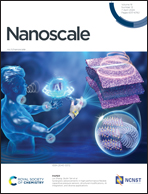Macrophage membrane-modified targeted phase-change nanoparticles for multimodal imaging of experimental autoimmune myocarditis†
Abstract
Myocarditis is an important public health issue due to the high prevalence of sudden death in adolescents and young adults. Nevertheless, the early identification of myocarditis remains a serious problem for clinicians. There is no single non-invasive method to diagnose myocarditis in the currently available clinical guidelines and consensus. Molecular imaging is an effective approach for accurate diagnosis. Poly(lactic acid-glycolic acid) (PLGA) is considered to be the preferred carrier for molecular imaging because of its biosafety and modifiability. Macrophage membrane-modified biomimetic nanoprobes (MM-NPs) possess low immunogenicity and inflammation-directed chemotaxis capabilities and are repeatedly chosen as materials for targeted diagnosis and treatment of inflammatory diseases. In this study, experimental autoimmune myocarditis (EAM) was used as an animal model of inflammation. Previous studies have confirmed that this model is similar to pathological injury caused by acute myocarditis in humans. In multimodal imaging (US/PA/MRI), a phase-change material (PFH) and superparamagnetic iron oxide (SPIO) are used as imaging substances. Early identification of myocardial inflammatory sites was achieved by the tail vein injection of MM/NPs loaded with PFH and SPIO. This probe is expected to be a powerful tool for clinicians to diagnose myocarditis.



 Please wait while we load your content...
Please wait while we load your content...